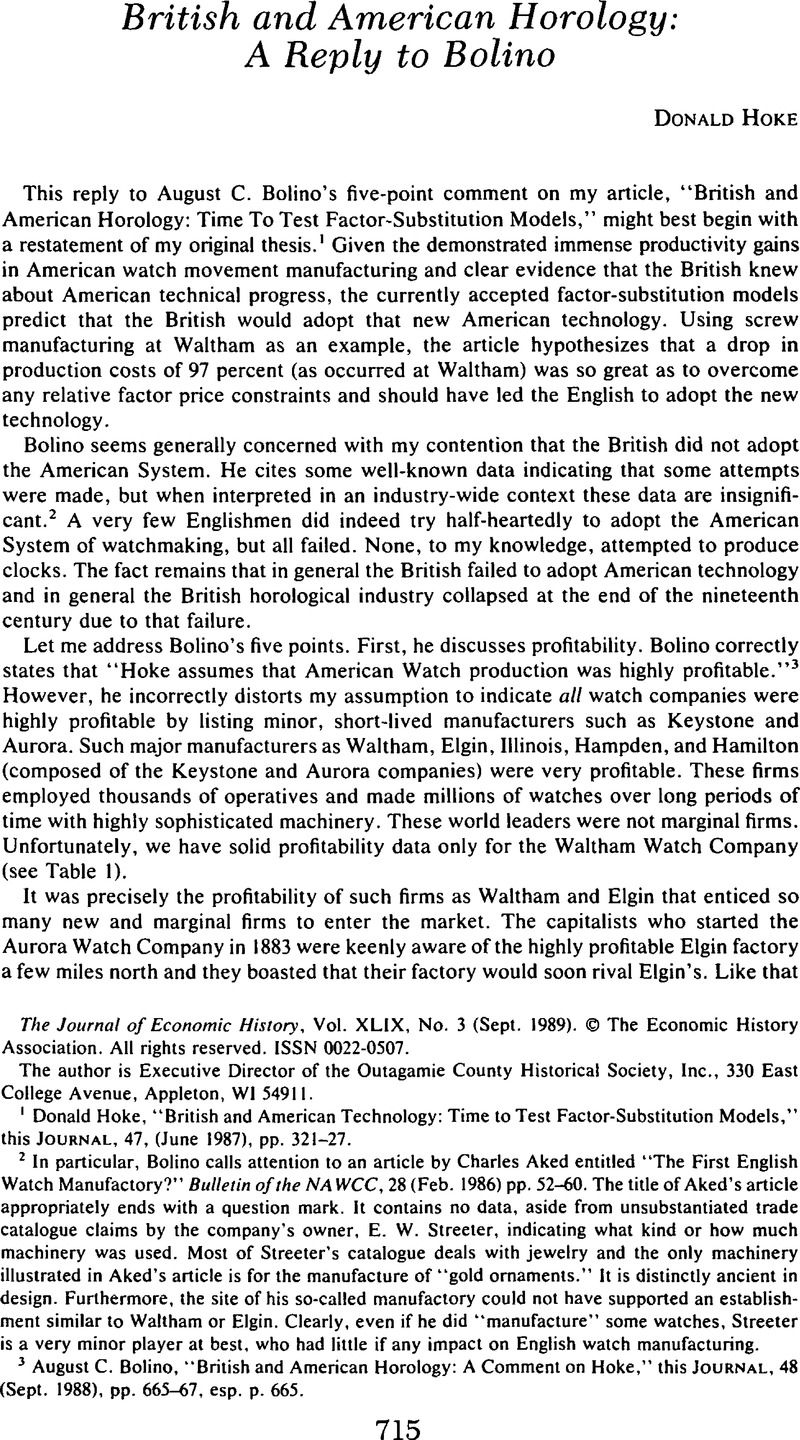No CrossRef data available.
Article contents
British and American Horology: A Reply to Bolino
Published online by Cambridge University Press: 03 March 2009
Abstract

- Type
- Notes and Discussion
- Information
- Copyright
- Copyright © The Economic History Association 1989
References
1 Hoke, Donald, “British and American Technology: Time to Test Factor-Substitution Models,” this Journal, 47, (06 1987), pp. 321–27.Google Scholar
2 In particular, Bolino calls attention to an article by Aked, Charles entitled “The First English Watch Manufactory?” Bulletin of the NAWCC, 28 (02 1986) pp. 52–60. The title of Aked's article appropriately ends with a question mark. It contains no data, aside from unsubstantiated trade catalogue claims by the company's owner, E. W. Streeter, indicating what kind or how much machinery was used. Most of Streeter's catalogue deals with jewelry and the only machinery illustrated in Aked's article is for the manufacture of “gold ornaments.” It is distinctly ancient in design. Furthermore, the site of his so-called manufactory could not have supported an establishment similar to Waltham or Elgin. Clearly, even if he did “manufacture” some watches, Streeter is a very minor player at best, who had little if any impact on English watch manufacturing.Google Scholar
3 August Bolino, C., “British and American Horology: A Comment on Hoke,” this Journal, 48 (09 1988), pp. 665–67, esp. p. 665.Google Scholar
4 Bolino, “Comment on Hoke,” p. 666. The second sentence is quoted without attribution from my dissertation.Google Scholar
5 Hounshell, David A., From the American System to Mass Production, 1800–1932. The Development of Manufacturing Technology in the United States (Baltimore, 1984).Google Scholar
6 Hoke, Donald R., Ingenious Yankees: The Rise of the American System of Manufactures in the Private Sector (New York, forthcoming 1989).Google Scholar
7 See, for example, Cooper, Carolyn C., “The Portsmouth System of Manufacture,” Technology & Culture, 25 (04 1984), pp. 182–225.CrossRefGoogle Scholar
8 Bolino,“Comment on Hoke,” p. 666.Google Scholar
9 See, for example, Gordon, Robert B., “Who Turned the Mechanical Ideal into Mechanical Reality?” Technology & Culture, 29 (10 1988), pp. 744–78. See also, generally, the works of John Harris on British coal fuel technology.CrossRefGoogle Scholar
10 Bolino, “Comment on Hoke,” p. 666.Google Scholar
11 The technological conservatism of British watch manufacturers can also be found in the design of English watches. Many watches needlessly retained the chain and fusee well into the 1880s, long after both the Americans and the Swiss had abandoned them.Google Scholar
12 American Watch Tool Company, American Watch Tool Company, Waltham, Mass., Manufacturers of the Whitcomb Lathe (May, 1884), p. 22.Google Scholar
13 Smith, Alan, The Lancashire Watch Company, Prescot, Lancashire, England, 1889–1910 (Fitzwilliam, N. H., 1973), p. 29.Google Scholar
14 For an example of the Lancashire watch, see Inventory 1404, in my The Time Museum Catalogue of American Watches (Rockford, IL, Fall 1989).Google Scholar
15 Bolino, “Comment on Hoke,” p. 667.Google Scholar
16 “Watchmaking in America,” The Illustrated London News, June 19, 1875, pp. 591–92.Google Scholar




